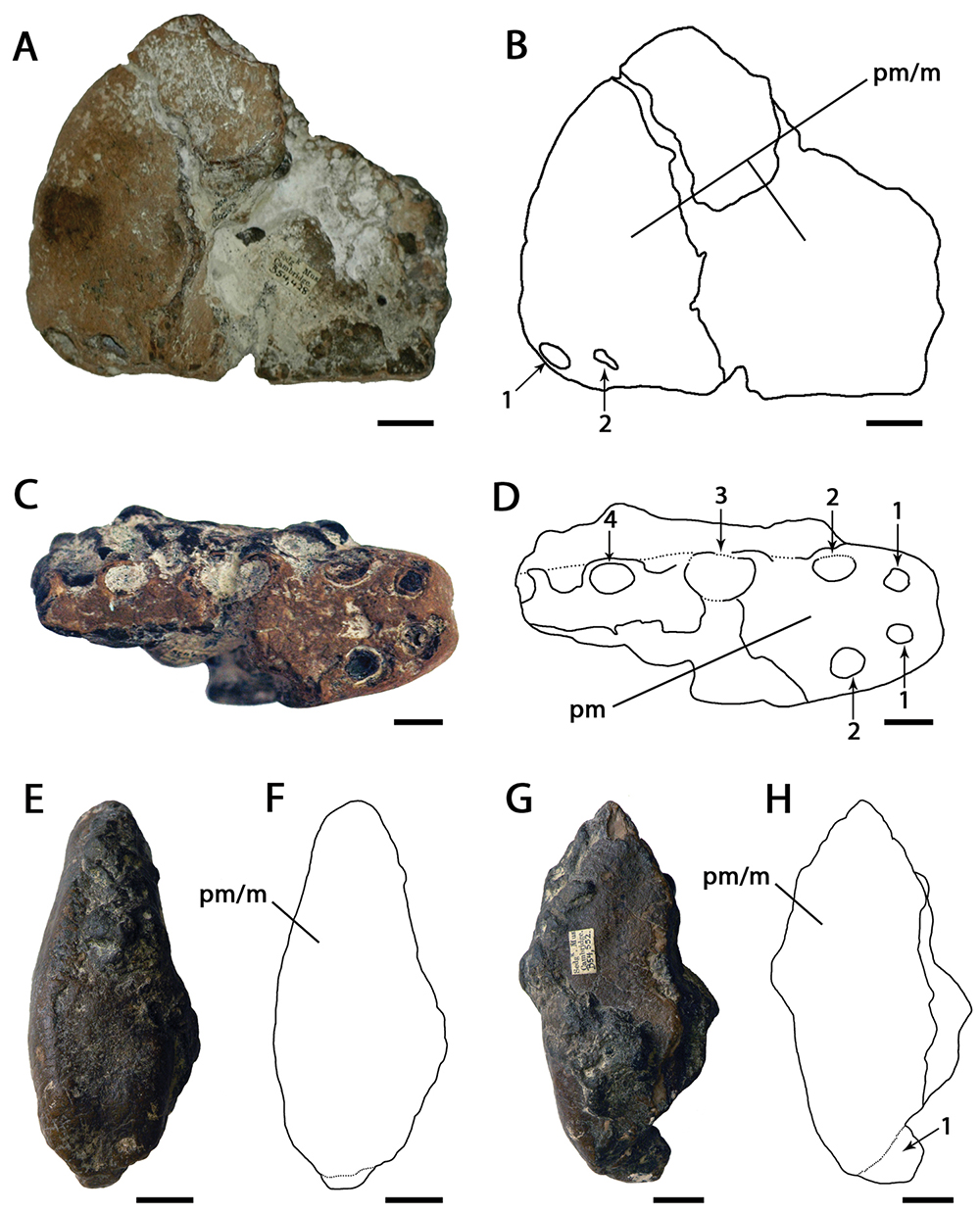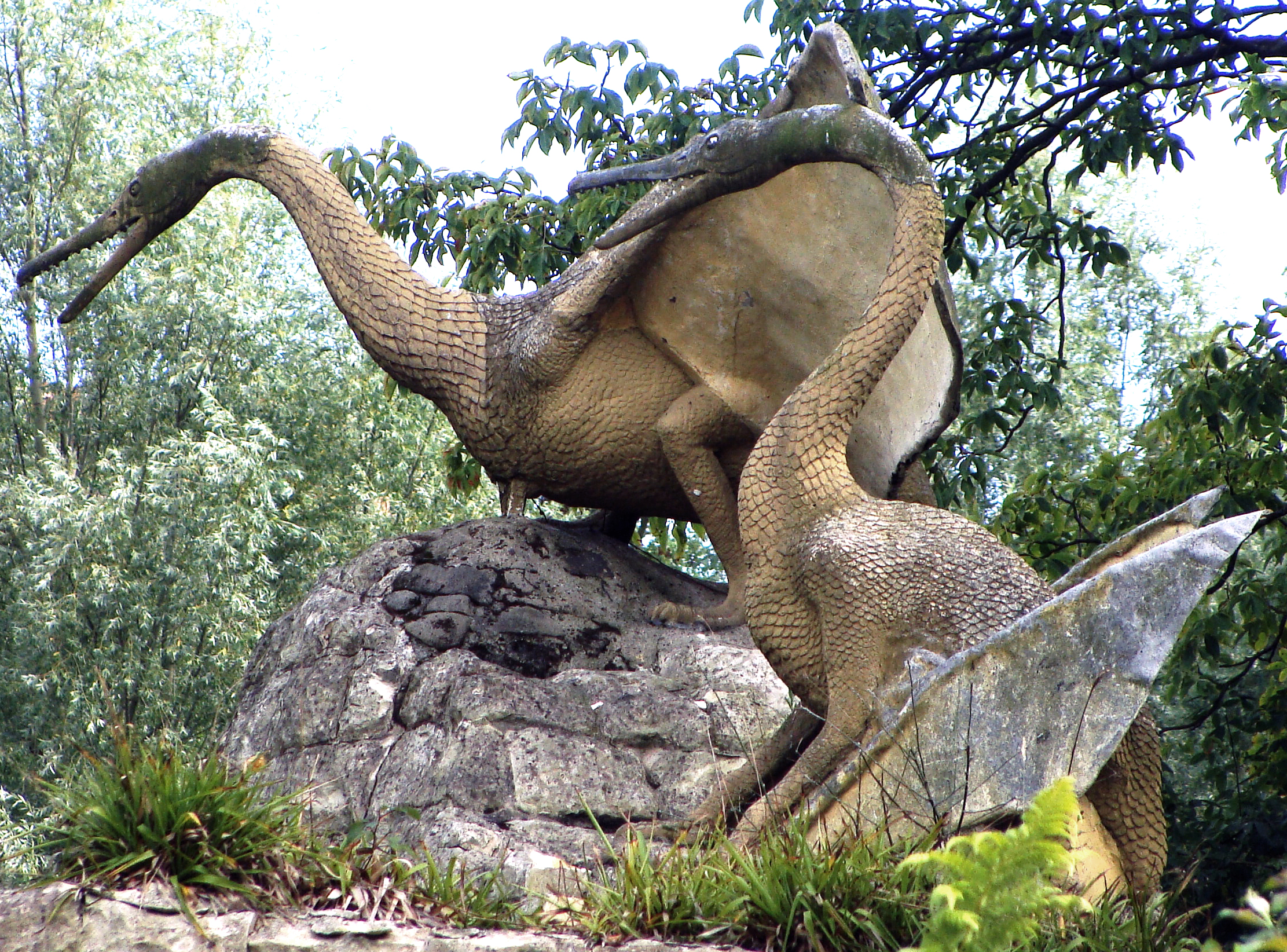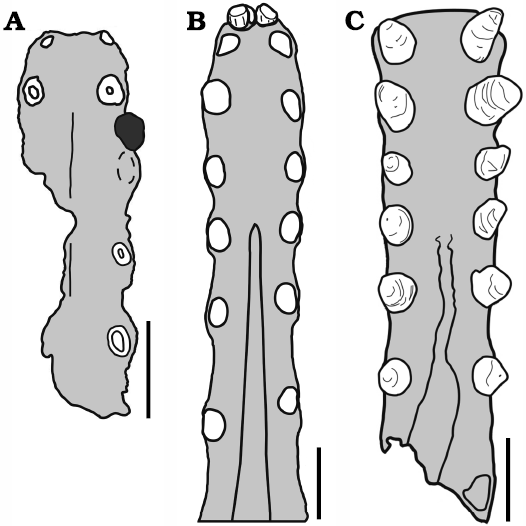|
Ornithocheirae
Ornithocheirae is an extinct clade of pteranodontoid pterosaurs from the Early Cretaceous to the Late Cretaceous (Valanginian to Turonian stages) of Asia, Europe, North America and South America. It was named by Harry Seeley in 1870 as a family that contains ''Ornithocheirus'' and its relatives. The name was emended to Ornithocheiridae, to match the requirements of the ICZN Code that a family-ranked clade should end with an -idae suffix. Brian Andres (2010) in his review of pterosaur phylogeny, defined the name Ornithocheirae phylogenetically, as a node-based taxon consisting of the last common ancestor of ''Anhanguera'' and ''Ornithocheirus'' and all its descendants. Thus Ornithocheirae is defined to include two families, the Anhangueridae and the Ornithocheiridae, following the opinion of Alexander KellnerKellner, A. W. A., (2003): Pterosaur phylogeny and comments on the evolutionary history of the group. pp. 105-137. — ''in'' Buffetaut, E. & Mazin, J.-M., (eds.): ''Evolut ... [...More Info...] [...Related Items...] OR: [Wikipedia] [Google] [Baidu] |
Anhangueria
Anhangueria (or anhanguerians) is a group of pterosaurs belonging to the clade Pteranodontoidea. Fossil remains of this group date back from the Early to Late Cretaceous periods (Valanginian to Turonian stages), around 140 to 92.5 million years ago. Anhangueria was named by paleontologists Taissa Rodrigues and Alexander Kellner in a review of ''Ornithocheirus'' species in 2013, they defined the clade as a branch-based taxon consisting of all pteranodontoids more closely related to ''Anhanguera blittersdorffi'' than to ''Istiodactylus latidens'' and ''Cimoliopterus cuvieri''. Classification Anhangueria originally only contained the genera '' Brasileodactylus'', ''Camposipterus'', ''Cearadactylus'', ''Ludodactylus'' as well as the family Anhangueridae, however, recent analyses had recovered the family Hamipteridae within this clade as well. In 2014, paleontologist Brian Andres and colleagues assigned more groups and genera within this clade, this included ''Guidraco'', the subfa ... [...More Info...] [...Related Items...] OR: [Wikipedia] [Google] [Baidu] |
Ornithocheiridae
Ornithocheiridae (or ornithocheirids, meaning "bird hands") is a group of pterosaurs within the suborder Pterodactyloidea. These pterosaurs were among the last to possess teeth. Members that belong to this group lived from the Early to Late Cretaceous periods (Valanginian to Turonian stages), around 140 to 90 million years ago. Ornithocheirids are generally infamous for having an enormously controversial and very confusing taxonomy. Although agreements that these animals were related, and therefore similar to istiodactylids and pteranodontians, there is still no virtual consensus over the exact content and interrelationships of this group. Ornithocheirids were the most successful pterosaurs during their reign, they were also the largest pterosaurs before the appearance of the azhdarchids such as ''Quetzalcoatlus''. Ornithocheirids were excellent fish hunters, they used various flight techniques to catch their prey, and they are also capable of flying great distances without fl ... [...More Info...] [...Related Items...] OR: [Wikipedia] [Google] [Baidu] |
Cimoliopterus
''Cimoliopterus'' is a genus of pterosaur that lived during the Late Cretaceous in what is now England and the United States. The first known specimen, consisting of the front part of a snout including part of a crest, was discovered in the Grey Chalk Subgroup of Kent, England, and described as the new species ''Pterodactylus cuvieri'' in 1851. The specific name ''cuvieri'' honours the palaeontologist George Cuvier, whereas the genus ''Pterodactylus'' was then used for many pterosaur species that are not thought to be closely related today. It was one of the first pterosaurs to be depicted as models in Crystal Palace Park in the 1850s. The species was subsequently assigned to various other genera, including ''Ornithocheirus'' and ''Anhanguera''. In 2013, the species was moved to a new genus, as ''Cimoliopterus cuvieri''; the generic name ''Cimoliopterus'' is derived from the Greek words for "chalk" and "wing". Other specimens and species have also been assigned to or synonymi ... [...More Info...] [...Related Items...] OR: [Wikipedia] [Google] [Baidu] |
Ornithocheirus
''Ornithocheirus'' (from Ancient Greek "ὄρνις", meaning ''bird'', and "χεῖρ", meaning ''hand'') is a pterosaur genus known from fragmentary fossil remains uncovered from sediments in the UK and possibly Morocco. Several species have been referred to the genus, most of which are now considered as dubious species, or members of different genera, and the genus is now often considered to include only the type species, ''Ornithocheirus simus''. Species have been referred to ''Ornithocheirus'' from the mid-Cretaceous period of both Europe and South America, but ''O. simus'' is known only from the UK, though a specimen referred to ''O.'' cf. ''simus'' is also known from Morocco. Because ''O. simus'' was originally named based on poorly preserved fossil material, the genus ''Ornithocheirus'' has suffered enduring problems of zoological nomenclature. Fossil remains of ''Ornithocheirus'' have been recovered mainly from the Cambridge Greensand of England, dating to the beginni ... [...More Info...] [...Related Items...] OR: [Wikipedia] [Google] [Baidu] |
Ornithocheirus & Tropeognathus
''Ornithocheirus'' (from Ancient Greek "ὄρνις", meaning ''bird'', and "χεῖρ", meaning ''hand'') is a pterosaur genus known from fragmentary fossil remains uncovered from sediments in the UK and possibly Morocco. Several species have been referred to the genus, most of which are now considered as dubious species, or members of different genera, and the genus is now often considered to include only the type species, ''Ornithocheirus simus''. Species have been referred to ''Ornithocheirus'' from the mid-Cretaceous period of both Europe and South America, but ''O. simus'' is known only from the UK, though a specimen referred to ''O.'' cf. ''simus'' is also known from Morocco. Because ''O. simus'' was originally named based on poorly preserved fossil material, the genus ''Ornithocheirus'' has suffered enduring problems of zoological nomenclature. Fossil remains of ''Ornithocheirus'' have been recovered mainly from the Cambridge Greensand of England, dating to the beginni ... [...More Info...] [...Related Items...] OR: [Wikipedia] [Google] [Baidu] |
Targaryendraconia
Targaryendraconia is an extinct clade of lanceodontian pterosaurs that lived from the Early to Late Cretaceous period in Europe, North America, South America, and Australia. Classification Below is a cladogram following a topology by Pêgas and colleagues in 2019. In their analysis, they recovered Targaryendraconia as the sister taxon of the clade Anhangueria, both of which are within the more inclusive group Ornithocheirae. Targaryendraconia is split into two families: the Targaryendraconidae, which contains ''Aussiedraco'', '' Barbosania'', and ''Targaryendraco'', and the Cimoliopteridae, which contains ''Aetodactylus'', ''Camposipterus ''Camposipterus'' is a genus of pterodactyloid pterosaur from the Early Cretaceous of England. Fossil remains of ''Camposipterus'' dated back to the Early Cretaceous, about 112 million years ago. Discovery and naming In 1869, Harry Govier Seel ...'', and '' Cimoliopterus''. References Pteranodontoids Hauterivian first appeara ... [...More Info...] [...Related Items...] OR: [Wikipedia] [Google] [Baidu] |
Camposipterus
''Camposipterus'' is a genus of pterodactyloid pterosaur from the Early Cretaceous of England. Fossil remains of ''Camposipterus'' dated back to the Early Cretaceous, about 112 million years ago. Discovery and naming In 1869, Harry Govier Seeley, based on a fossil found at Haslingfield, Cambridgeshire, named ''Ptenodactylus nasutus'',Seeley, H.G., 1869, ''Index to the fossil remains of Aves, Ornithosauria, and Reptilia, from the Secondary System of Strata arranged in the Woodwardian Museum of the University of Cambridge''. Deighton, Bell and Co., Cambridge, xxiii + 143 pp at the same time disclaiming the name which makes it invalid by modern standards. In 1870, Seeley had realized that the generic name ''Ptenodactylus'' had been preoccupied, so he renamed the species into ''Ornithocheirus nasutus''.Seeley, H.G., 1870, ''The Ornithosauria: an elementary study of the bones of pterodactyls, made from fossil remains found in the Cambridge Upper Greensand, and arranged in the Woodwar ... [...More Info...] [...Related Items...] OR: [Wikipedia] [Google] [Baidu] |
Pterosaur
Pterosaurs (; from Greek ''pteron'' and ''sauros'', meaning "wing lizard") is an extinct clade of flying reptiles in the order, Pterosauria. They existed during most of the Mesozoic: from the Late Triassic to the end of the Cretaceous (228 to 66 million years ago). Pterosaurs are the earliest vertebrates known to have evolved powered flight. Their wings were formed by a membrane of skin, muscle, and other tissues stretching from the ankles to a dramatically lengthened fourth finger. There were two major types of pterosaurs. Basal pterosaurs (also called 'non-pterodactyloid pterosaurs' or 'rhamphorhynchoids') were smaller animals with fully toothed jaws and, typically, long tails. Their wide wing membranes probably included and connected the hind legs. On the ground, they would have had an awkward sprawling posture, but the anatomy of their joints and strong claws would have made them effective climbers, and some may have even lived in trees. Basal pterosaurs were insectiv ... [...More Info...] [...Related Items...] OR: [Wikipedia] [Google] [Baidu] |
Anhanguera (pterosaur)
''Anhanguera'' () is a genus of pterodactyloid pterosaur known from the Early Cretaceous (Albian age, 125 to 112 million years ago) Romualdo Formation of Brazil and the Late Cretaceous ( Cenomanian age, 98 to 92.5 million years ago) Kem Kem Group of Morocco. This pterosaur is closely related to ''Ornithocheirus'', but belongs in the family Anhangueridae.Campos, D. de A., and Kellner, A. W. (1985). "Um novo exemplar de ''Anhanguera blittersdorffi'' (Reptilia, Pterosauria) da formação Santana, Cretaceo Inferior do Nordeste do Brasil." In Congresso Brasileiro de Paleontologia, Rio de Janeiro, Resumos, p. 13. The generic name comes from the Tupi words ''añanga'', meaning "spirit protector of the animals" + ''wera'' "bygone". Description ''Anhanguera'' was a fish-eating animal with a wingspan of about .Aureliano, T., Ghilardi, A. M., Duque, R. R., & Barreto, A. M. (2014). ON THE OCCURRENCE OF PTEROSAURIA IN EXU, PERNAMBUCO (LOWER CRETACEOUS ROMUALDO FORMATION, ARARIPE BASIN), N ... [...More Info...] [...Related Items...] OR: [Wikipedia] [Google] [Baidu] |
Anhangueridae
Anhangueridae is a group of pterosaurs within the suborder Pterodactyloidea. They were among the last pterosaurs to possess teeth. A recent study discussing the group considered the Anhangueridae to be typified by a premaxillary crest and a lateral expansion in the distal rostrum. The same study presented a cladistic analysis, for which an "agreement subtree" was calculated. The Anhangueridae was found to be sister taxon to the large crested ''Tropeognathus''. Relationships There are competing theories of ornithocheiromorph phylogeny (evolutionary relationships). Below is cladogram following a topology recovered by Brian Andres, using the most recent iteration of his data set. The cladogram below follows Pêgas ''et al.'' (2019), who recovered Anhangueridae as a much more inclusive group. The analysis found most of the ornithocheirids falling into this family, while ''Ornithocheirus'' itself was recovered as a basal member of Ornithocheirae Ornithocheirae is an extinct clad ... [...More Info...] [...Related Items...] OR: [Wikipedia] [Google] [Baidu] |
Siroccopteryx
''Siroccopteryx'' is an extinct genus of anhanguerid pterodactyloid pterosaur, known from middle Cretaceous (between the Albian and Cenomanian stages, about 105 million years ago) sediments in modern-day Morocco. Some researchers, such as David M. Unwin, consider the genus a junior synonym of ''Coloborhynchus''. Description The genus was named and described in 1999 by Bryn Mader and Alexander Kellner. The name ''Siroccopteryx'' means "wing of the Sirocco", referring to the warm wind that originates in the North Africa and then goes through the Mediterranean, and the Greek word ''pteryx'', a standard suffix for pterosaur genera that means "wing". The epithet of the type species ''S. moroccensis'' refers to its country of origin. This pterosaur is known only from the front part of the jaw with teeth. The holotype fossil, LINHM 016 (Long Island Natural History Museum), was found near Ksar es Souk, in the province of Errachidia in the region of Meknes-Tafilalet at 30.4 ° N, 4 ... [...More Info...] [...Related Items...] OR: [Wikipedia] [Google] [Baidu] |
Pteranodontoid
Pteranodontoidea (or pteranodontoids, from Greek meaning "toothless wings") is an extinct clade of ornithocheiroid pterosaurs from the Early to Late Cretaceous (early Valanginian to late Maastrichtian stages) of Asia, Africa, Europe, North America and South America. It was named by Alexander Wilhelm Armin Kellner in 1996. In 2003, Kellner defined the clade as a node-based taxon consisting of the last common ancestor of ''Anhanguera'', ''Pteranodon'' and all its descendants. The clade Ornithocheiroidea is sometimes considered to be the senior synonym of Pteranodontoidea, however it depends on its definition.Unwin, D. M., (2003): On the phylogeny and evolutionary history of pterosaurs. pp. 139-190. — ''in'' Buffetaut, E. & Mazin, J.-M., (eds.): ''Evolution and Palaeobiology of Pterosaurs''. Geological Society of London, Special Publications 217, London, 1-347 Brian Andres (2008, 2010, 2014) in his analyses, converts Ornithocheiroidea using the definition of Kellner (2003) to a ... [...More Info...] [...Related Items...] OR: [Wikipedia] [Google] [Baidu] |










